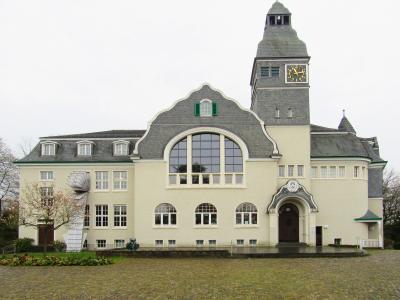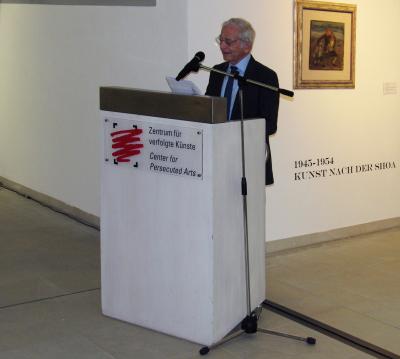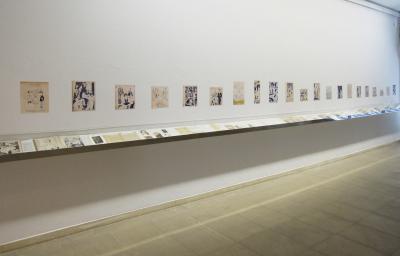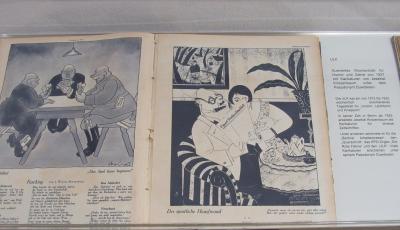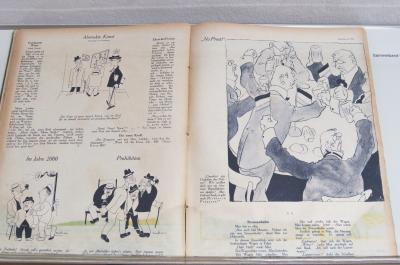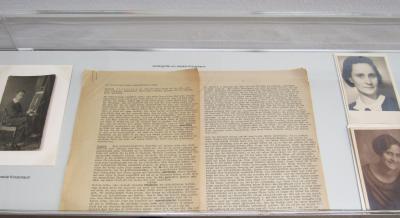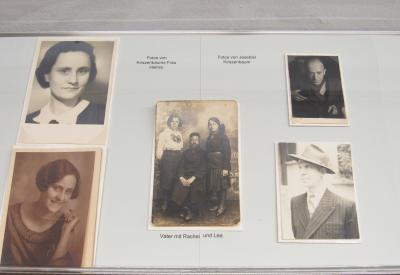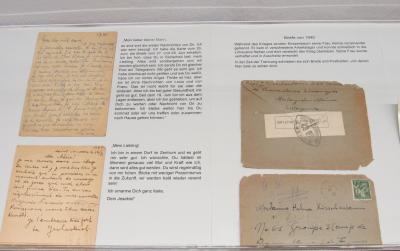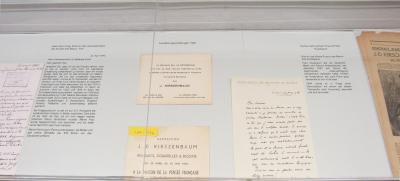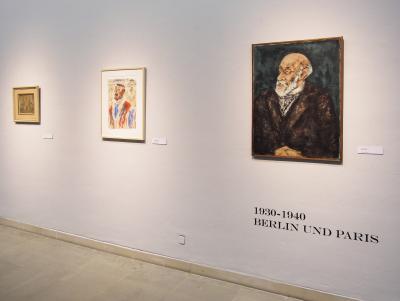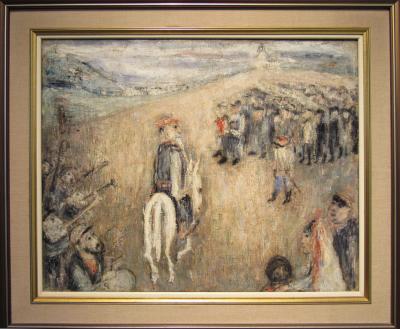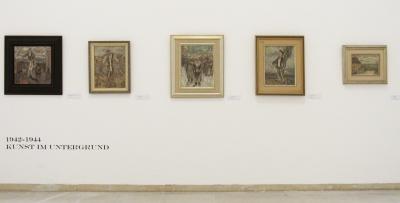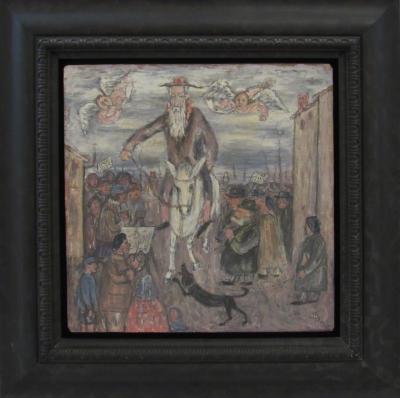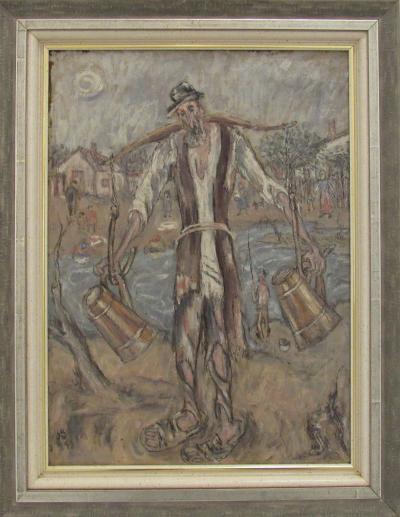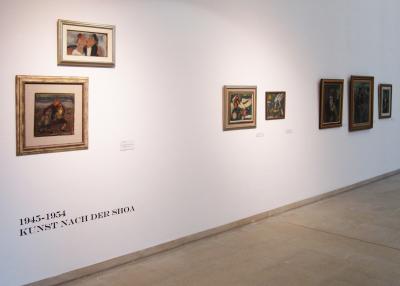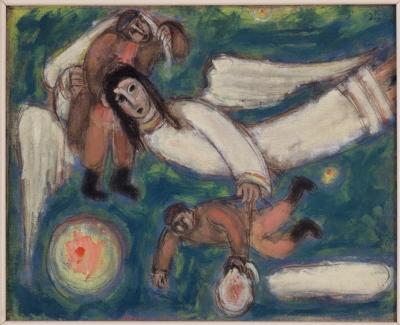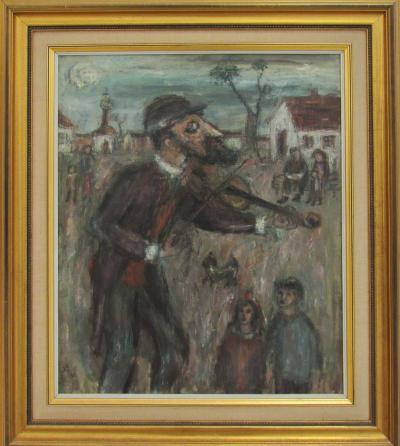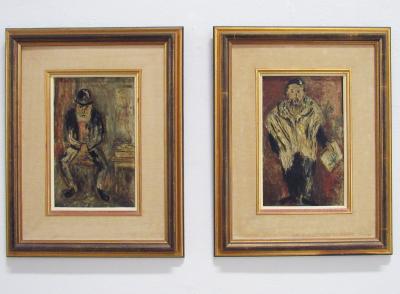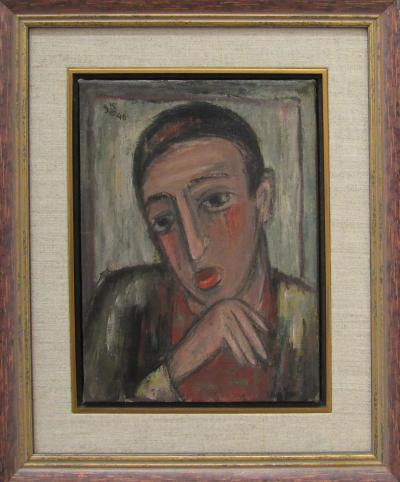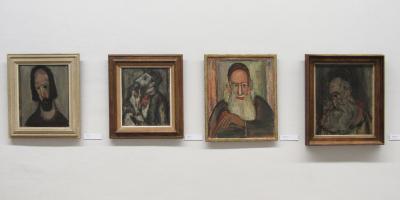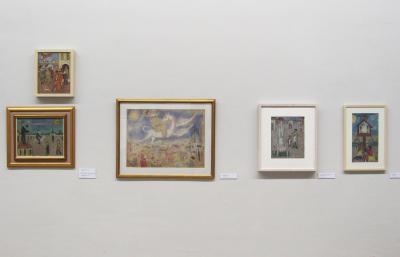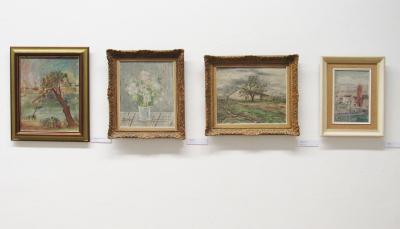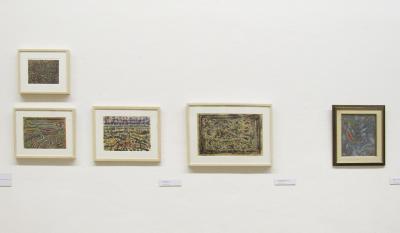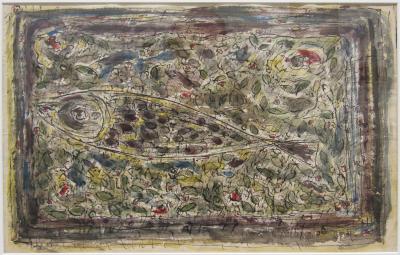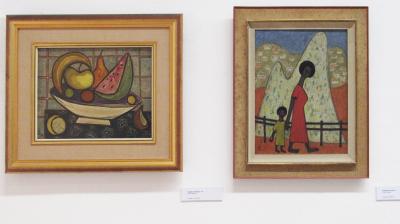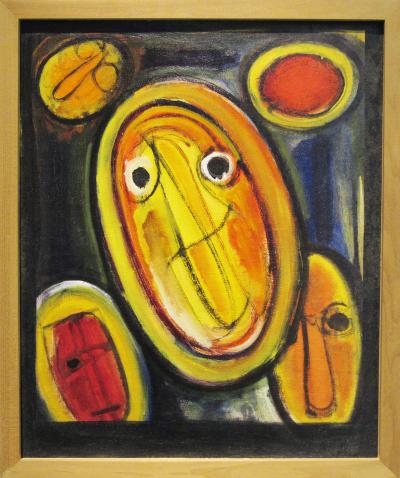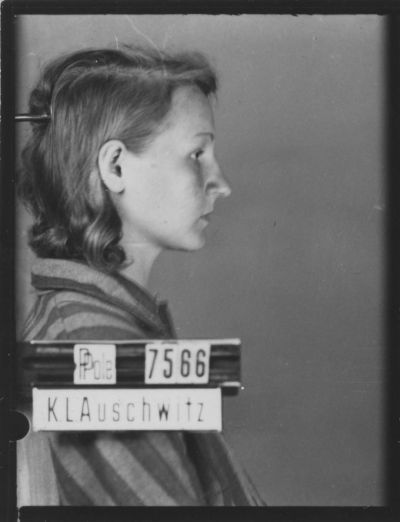Jesekiel Kirszenbaum – Exhibition in Solingen
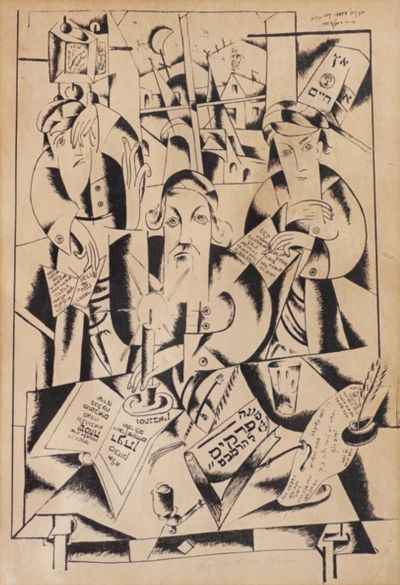
At the opening of the exhibition, it was announced that the initiative for the exhibition came from the bank director Jürgen Vits (Frankfurt am Main), a member of the Friends of the Solingen Zentrum für verfolgte Künste and the association Gegen das Vergessen - Für Demokratie e.V. The latter had discovered a personal connection with Kirszenbaum a few years before. From 1942 to 1944 his great-uncle's family in Belgium had hidden a Jewish child, Amos Diament, from the National Socialists. In 2004, the Israeli memorial Yad Vashem honoured them as "Righteous Among the Nations". Amos and his brother Nathan Diament who was rescued by another Belgian family, emigrated to Israel in 1949 along with their parents who also survived in Belgium. The two brothers are grand-nephews of Jesekiel Kirszenbaum. For about fifteen years they have been committed to preserving his artistic legacy and making it known to the public once again. A meeting with Herr Vits in Israel gave rise to the idea of an exhibition in Germany, which could now be implemented in the Zentrum für verfolgte Künste in Solingen (ill. 1), featuring works from the family's holdings and private collections. The exhibition was curated by Nathan Diament (Tel-Aviv, ill. 2), who for years has been promoting Kirszenbaum's works in the archives of numerous museums and collections. In 2012 he published a book about his great-uncle. He also runs a website and has initiated other exhibitions alongside that presented by Jürgen Kaumkötter M.A., the curator and director of the collections at the Solingen Centre. This exhibition was preceded by one in the Mimara Museum in Zagreb. The opening of the exhibition in Solingen was attended by Nathan and Amos Diament as well as descendants of the Belgian families to whom they owe their survival.
The exhibition began with two ink drawings "Studying Maimonides" (title picture) and "Musicians and their Followers" made in Berlin in 1925, immediately after Kirszenbaum's studies at the Bauhaus. They are executed in a two-dimensional style with overlapping geometric forms and reflect contemporary art movements somewhere between Dada and Cubism. The contrasting black and white structure is reminiscent of woodcuts and linocuts created by numerous artists at the time as illustrations and graphic supplements for magazines like Der Sturm. Perhaps they were even intended as models for such illustrations, for in the same year Kirszenbaum was already working for the Berlin magazine Gebrauchsgraphik and had probably already met the editor of the magazine Der Sturm and director of the Sturm-Galerie, Herwarth Walden, through his friend at the Bauhaus, Paul Citroen (1896-1983), who had close connections to the Dada group. The motifs are everyday scenes from the Stetl, the Jewish settlements in eastern Europe. Kirszenbaum knew them from his childhood and youth in Staszów, a town with around nine thousand inhabitants over half of whom were Jewish. Throughout his life he captured them in pictures from memory. These pictures included people studying old Jewish writings in the Cheder, the religious primary school, and traditional fiddlers, whose music attracted not only the townspeople, but also – think of similar motifs by Chagall – all kinds of animals.
As a caricaturist for the magazine Ulk, an illustrated weekly newspaper for humour and satire published by Rudolf Mosse's Berlin publishing house, Kirszenbaum presented himself as a cosmopolitan portrayer of the metropolitan society of the "Golden Twenties". His caricatures, which were published in Ulk from 1926 to 1929 under the pseudonym "Duwdiwani", the Hebrew word for "Kirschbaum", were represented in the exhibition by reproductions and two original anthologies of the magazine (ill. 3-5). They showed characters from the Weimar period at home at the coffee table with the sporting supplement of the Berliner Tageblatt (ill. 4); as exhibition visitors ("Nature is quite simply kitsch, and any guy who paints it makes me want to vomit!"); as future visionaries "In the Year 2000"; and as alcoholics during the Prohibition years in America" ("Yes, we alcoholics have it hard. Three of us always have to stand as backdrops, while the fourth slurps from the bottle, ill. 5). Artistically they vary from a striking black-and-white style – as cultivated by other artists in Ulk or in the Munich magazines Jugend and Simplicissimus – to biting Dadaist excesses in a linear style, as we know them from George Grosz.
A collection of personal documents showed a few remnants of a life caught between flight and persecution and in exile, these being special treasures from the family estate. Presented in a long row on a desk under glass, they also served as a timeline and substitute for the biography usually required at the beginning of an exhibition. The exhibition included early photographs and a typewritten autobiography recalling his childhood in Staszów (ill. 6, 7). Excerpts from Parisian newspapers and magazines published in 1933 report on exhibitions in Paris in which Kirszenbaum participated after his flight, and where he successfully presented himself as a young member of the École de Paris. Finally, there were letters written in 1940 between Kirszenbaum and his wife Helma, after he had been deported to a camp in Meslay du Maine, east of Rennes, when the war broke out in 1939 (ill. 8). In 1941 he was transferred to a camp for foreign workers in Bellac in Limousin. His wife, too, initially passed through a camp in Gurs, was released once more, arrested in 1943, and deported a year later to the Auschwitz-Birkenau concentration camp, where she was murdered.
A letter after the end of the war in which the artist asked the Director General of the Royal Museums of Art in Brussels about the possibility of an exhibition, showed that he had managed to escape from the labour camp in 1942 and remain in hiding until the end of the war, while six hundred artworks were looted from his apartment in Paris by the Germans. Kirszenbaum wrote that he had received no news about the fate of his wife. When, in another letter to Brussels, he inquired about the whereabouts of his friend, the painter Felix Nussbaum (1904-1944), he was informed that Nussbaum and his wife had not returned from being deported to a concentration camp (ill. 9). Invitation cards, catalogues, photographs and the poster of a retrospective in 1962 at the Galerie Karl Flinker in Paris described Kirszenbaum's artistic activities until his early death in Paris in 1954. He had solo exhibitions in Lyon in 1946 at the Maison de la Pensée Française, in Paris in 1947 at the Galerie Quatre Chemins, in 1951 at the Galerie André Weil, and in 1953 at the Galerie Au Pont des Arts. Above all, however, Baroness Alix de Rothschild, who helped persecuted artists after the war, looked after Kirszenbaum, took painting lessons from him, acquired his works, and exhibited his current works, "Arts sacrés, sujets religieux", in 1947 at her estate on Avenue Foch 21 in Paris. In 1946 he also took part in the exhibition of the Salon de Mai artists' group, which had been founded in 1943 during the German occupation of Paris to oppose the National Socialists. He also took part in the Salon des Tuileries in 1946, in the exhibition of the artist group Les Surindépendants in 1947, which he joined in the following year, and in the Salon des peintres témoins de leur temps in 1954.
Due to the loss of almost all of his early works, the exhibition only included one painting from the Berlin period, a portrait of Sigmund Freud from 1930 (ill. 10, right), and three paintings from the first Parisian period until the outbreak of the Second World War. The only compensation for this were loans from distant museums, such as a self-portrait in the Frans Hals Museum in Haarlem, painted in Berlin in 1925, and Jewish scenes painted in Paris in the 1930s that are now held in Israeli museums. Whereas the Freud Portrait, (about which nothing more is known and which may have been painted from a photograph), with its stiff posture and coarsely executed hands is reminiscent of portraits by Oskar Kokoschka from the 1910s or by Chaim Soutine a decade later, Kirszenbaum discovered his own style later in Paris. By studying the Impressionists in museums and galleries and under the influence of the École de Paris, which expanded considerably during this period, especially with immigrants from Eastern Europe, Kirszenbaum became a master of grey tones and nuances, while structuring his pictures with isolated luminous colour effects. The "Man with Cigarette" (ill. 10, centre), a 1935 ink drawing, shows an everyday scene from Staszów. The "Arrival of the Messiah in the Village" (1939, ill. 11) is one of several similar paintings in which he depicts Jesus entering Jerusalem riding like a Hasidic Jew on a white donkey into Staszów or a Jewish village. Kirszenbaum thus linked biblical tradition with his memory of life in the Stetl. He may have used a painting by James Ensor, the "Entry of Christ into Brussels" (1888), as his inspiration for the idea.
After the artist managed to escape from the Bellac labour camp in 1942, he hid in Limoges and finally until the end of the war in Lyon in the unoccupied part of France. He created paintings both in the camp and in the underground, five of which were on display in the exhibition (ill. 12): "The Messiah and the Angels Arrive in the Village" (1942, ill. 13), showing a large crowd of people and the painter with his palette capturing the scene; a "Water Bearer" (1942, ill. 14) as Kirszenbaum remembered him during his childhood in Staszów; a "Jew on a Wintery Road" (1942), a "Wood Gatherer" (1941), and a winter landscape from 1941. Here it remains unclear whether the painting shows an area in Poland or France. Three portraits led visitors into the post-war period: a blurred portrait of his lost wife Helma, probably drawn from memory; a self-portrait (1947); and a portrait of Kirszenbaum (ill. 15) drawn by Alix de Rothschild around 1950.
The period after the Second World War, summarised in the exhibition under the heading "Art after the Shoa" (ill. 16), amounted to a mere nine years in Kirszenbaum's life. However, this was when most of Kirszenbaum's works inevitably originated. In contrast to the preceding periods, these works in the exhibition were examples of larger groups of works that still exist in museums and private collections. As can be found in his writings, Kirszenbaum's personal situation was desperate. With neither money nor family, devastated by the loss of his wife and his life's work, he had to turn to the French state to survive. He found friends like Alix de Rothschild who helped him out of his financial and psychological distress, motivated him to resume his artistic work and take part in exhibitions.
In his paintings he dealt with the effects of the war. " The Flight of a Mother with two Children" (1945, ill. 16, left) is a variation on the theme of the eternally wandering, homeless, and fleeing Jews, which had occupied his mind in drawings, etchings, and paintings since 1938. On several occasions he painted angels carrying into eternity the "lost souls of the Stetls", for whom "there is no place left on earth" (ill. 17). He painted musicians (ill. 18) who, like the "Sitting Peddler" and the "Jewish Man with Tallit" (both around 1945, ill. 19), recall typical characters from Staszów and the lost world of Stetl. In Paris he could also have seen a "Trumpeter" (1946, ill. 20) and a "Violinist" (1949), both in a gala costume. Both allude to another theme that Kirszenbaum worked on during this period: clowns or, more generally, the circus (not represented in the exhibition), a theme often chosen by painters at the École de Paris, especially Georges Rouault (1871-1958), who is said to have been a friend of Kirszenbaum. The flat, luminous colours of these portraits are reminiscent of the Fauves, perhaps André Derain. More French influence – apparently that of Amedeo Modigliani (1884-1920), who died at an early age – can also be seen in the portrait of the young journalist Robert Giraud (1921-1997, ill. 21), painted in 1946. Kirszenbaum might have made his acquaintance in Limoges, where he had been arrested and threatened with death by the Germans as a member of the Resistance and who lived in Paris after the end of the war.
Kirszenbaum's return to his childhood in Staszów during these years also led to an increased preoccupation with the Old Testament and other religious themes. Amongst others, he created a monumental triptych featuring the prophets Moses, Elijah and Jeremiah in life-size formats (1947), that can be seen today in the Tel Aviv Museum of Art (not in the exhibition). This ambience also includes a group of portraits of Christian saints and Jewish thinkers (1945-47), including his own father, partly in Expressionist style, partly in Fauves flat style, but mostly in darker colours (ill. 22-23). He also began to project religious themes onto the site of his childhood again, but now in striking colours: once again the "Arrival of the Messiah in Stetl", and next to it a "Passing Angel" above the buildings and inhabitants of the city (both from 1946); a watercolour drawing of the "Rapture of the Prophet Elijah" on a winged horse against a similar backdrop (1954); and finally Jews "In front of a Christian Statue in the City" (ca. 1947) and "Praying Women" kneeling in front of a Marian column (1949) (ill. 24). Then again, in the fine grey tones of the early Parisian period with smaller colourings, there is an "Assembly under the Tree", presumably also a reminder of Staszów, and an unlocalised "Landscape". Both of these were created around 1947. In the exhibition they were linked for their stylistic congruence with a "Still Life with Flowers" and a "Landscape with a House" dating back to the time of his first imprisonment in Meslay du Maine in 1940 (ill. 25).
Kirszenbaum broadened his style considerably at the end of the 1940s, when some of his works with watercolours crossed the border to abstraction. Kirszenbaum now assembled free, somewhat organic forms, like those invented by Piet Mondrian and Wassily Kandinsky as early as 1910, with abstract textures and arabesques. During this time, Roger Bissière (1886-1964), a member of the École de Paris, turned to tableaux mixing representational and abstract forms, and this is also the case in Kirszenbaum's "Abstract Garden" (1949) and his "Fish with Abstract Background" (ca. 1948, ill. 26, 27). Here the influence of Paul Klee can be clearly seen. Kirszenbaum cultivated a friendly and collegial relationship with Klee during his studies at the Bauhaus, and wrote about the significance of this relationship for his work in his memoirs. In his early years Bissière was also inspired by Klee.
In 1948/49 Kirszenbaum travelled to Brazil to try to forget the memories of the sad mood and devastation in Europe. There he found not only a friendly welcome, but also a tropical world that inspired him to paint the country and its people in swathes of pure colour. These were still in the manner of the Fauves, but were also influenced by indigenous painting, and even visionary colour experiments (ill. 28, 29). During this time, in 1948, he even had exhibitions at the Galeria Domus, the leading art gallery in São Paulo, and in the same year at the Instituto de Arquitetos do Brasil in Rio de Janeiro. After his return to Paris, which had now become his real home, he became a French citizen in 1949. He subsequently travelled to Morocco in 1950 and to Italy, where he expanded his artistic interests to include nature, particularly exotic fruits and plants. His "Still Life with Fruit" (1952) is reminiscent of motifs by Paul Cézanne, but is nearer to Pablo Picasso in its moderate Cubism (ill. 28).
Between 1951 and 1953 Kirszenbaum fell seriously ill with cancer and died in Paris in 1954. For experts and art lovers the first retrospective of his work in Germany after almost ninety years at the Zentrum für verfolgte Künste in Solingen opened up a completely new view of a work that combines numerous aspects of modernism. Indeed it brought a hitherto unnoticed Bauhaus student into the public eye. Further exhibitions with a larger circle of lenders and more intensive scholarly work are eagerly awaited.
Axel Feuß, April 2019
We should like to express our gratitude to the Zentrum für verfolgte Künste (Solingen), Mr. Nathan Diament (Tel Aviv) and Ms. Anna Taube (Goethe Institute, Tel Aviv).
Further reading:
J.D. Kirszenbaum (1900-1954). The Lost Generation, edited by Nathan Diament and Caroline Goldberg Igra, Paris 2012
Johanna Linsler: Jesekiel David Kirszenbaum, entre aspiration révolutionnaire et mémoire du shtetl/Jesekiel David Kirszenbaum, zwischen revolutionärem Streben und Erinnerungen an das Schtetl, in: Anne Grynberg/Johanna Linsler (editors): L’Irréparable. Itinéraires d’artistes et d’amateurs d’art juifs, réfugiés du „Troisième Reich“ en France/Irreparabel. Lebenswege jüdischer Künstlerinnen, Künstler und Kunstkenner auf der Flucht aus dem „Dritten Reich“ in Frankreich, Magdeburg 2013, pages 265/290-313
J.D. Kirszenbaum (1900-1954). Retrospektiva/Retrospective. Exhibition catalogue: Muzej Mimara/The Mimara Museum, Zagreb 2018
